Confronting the Pet Obesity Crisis: Strategies for Healthy Weight Management


We all love a little extra fluff on our feline friends, but when does “fluffy” become a health issue? Cat obesity is on the rise, and at Animal Care Unlimited, we’re committed to ensuring our whiskered companions stay healthy, lively, and just the right amount of fluffy!
The Silent Epidemic: Cat Obesity
In recent years, we’ve seen an uptick in the number of overweight cats in our office. To the casual observer, a chubby cat may appear adorable and happy. But many don’t realize that beneath that purr-fectly plump exterior lies a pressing health concern.
While endearing overweight cats might evoke smiles and internet memes, looking beyond the surface is important. Much like humans, excessive weight in our feline friends is not just an aesthetic issue—it’s a significant health risk. The added weight puts undue strain on their bodies, and affects almost every organ system.
Potential Complications of Cat Obesity
- Diabetes: Overweight cats are at a higher risk of developing diabetes. This condition requires lifelong management and can significantly impact the quality of a cat’s life.
- Joint and Mobility Issues: Extra weight means added pressure on joints and bones. Over time, this can lead to arthritis, reducing a cat’s mobility, causing pain, and diminishing their overall zest for life.
- Respiratory and Heart Problems: Carrying extra weight can strain a cat’s respiratory system and heart, which leads to conditions such as asthma or even heart disease.
- Decreased Lifespan: Perhaps the most heart-wrenching fact is that obesity can cut short a cat’s life. A healthy weight is closely tied to longevity, ensuring our feline companions stay by our sides for as long as possible.
Recognizing cat obesity for the danger it is allows us to take timely action, prioritizing the health and well-being of our beloved pets.
Preventing Cat Obesity
Weight management isn’t just about reducing food intake—it’s a holistic approach that takes understanding and commitment. Here are a few insights to get started:
- Recognizing the signs: Identifying if your cat is overweight is the first step. Common indicators include difficulty feeling the ribs, a hanging belly, and lethargy.
- Balanced diet: Not all cat foods are created equal. Make sure you’re providing a nutritionally-balanced diet suitable for their age, breed, and health condition. Your vet can make recommendations suitable for your cat’s needs.
- Routine check-ups: Regular visits can help your vet monitor your cat’s weight and offer early intervention if any issues arise.
- Feeding routines: Establish set feeding times and avoid leaving food out for free access. Measure the portions to make sure your cat isn’t overeating.
Achieving Cat Weight Loss: Patience and Consistency
Facing the fact that your feline friend has become a little too round can be concerning. Yet, as with many challenges in life, approaching cat weight loss requires patience, dedication, and an informed strategy. It’s not just about shedding those extra pounds—it’s about ensuring the journey is safe, sustainable, and beneficial for your cat’s overall well-being.
- Realistic Goals are Key: Jumping headfirst into a rigorous weight loss plan can do more harm than good. Rapid weight loss in cats can be detrimental to their health, leading to issues such as liver disease. Instead, aim for a steady, gradual reduction with a consistent, month-by-month approach. Always work with your veterinarian, who can provide tailored advice and set achievable milestones for your pet.
- Consistency is Key: Cats are creatures of habit. They thrive on routine, and when it comes to their diet and exercise, maintaining a consistent regimen is pivotal. Those big, pleading eyes might tempt you to offer just one more treat, but you have to stay the course. Here’s how:
- Feeding: Measure out your cat’s food portions, and if possible, schedule feedings at the same times each day. This helps regulate calorie intake and gives them a sense of routine.
- Exercise: Engage your cat in daily play sessions. Toys, laser pointers, or even a simple feather can entice them to move. Consistent daily activity keeps them agile and burns off extra calories.
Maintaining a Healthy Weight
Unfortunately, as with humans, weight loss isn’t a “one-and-done” thing. You’ll need to keep an eye on your cat’s weight to make sure it doesn’t start creeping up again. With your vet’s help, determine how many calories your cat needs to maintain their sleek new physique and keep up the healthy habits you’ve established.
How Can We Help?
Achieving cat weight loss is a journey, one that requires commitment and understanding. But with patience, consistent efforts, and the proper guidance, your feline friend can regain their health and vitality, ensuring many more years of purrs and cuddles.
If you have concerns about your pet’s weight or need guidance on feline weight management, the Animal Care Unlimited team is here to help. Contact us so we can work toward a vibrant, active, and healthy life for your beloved cat.
